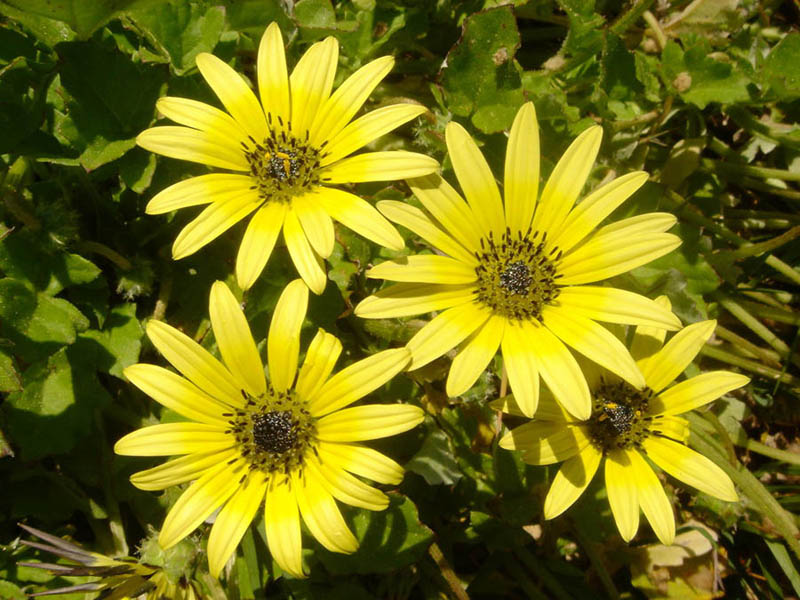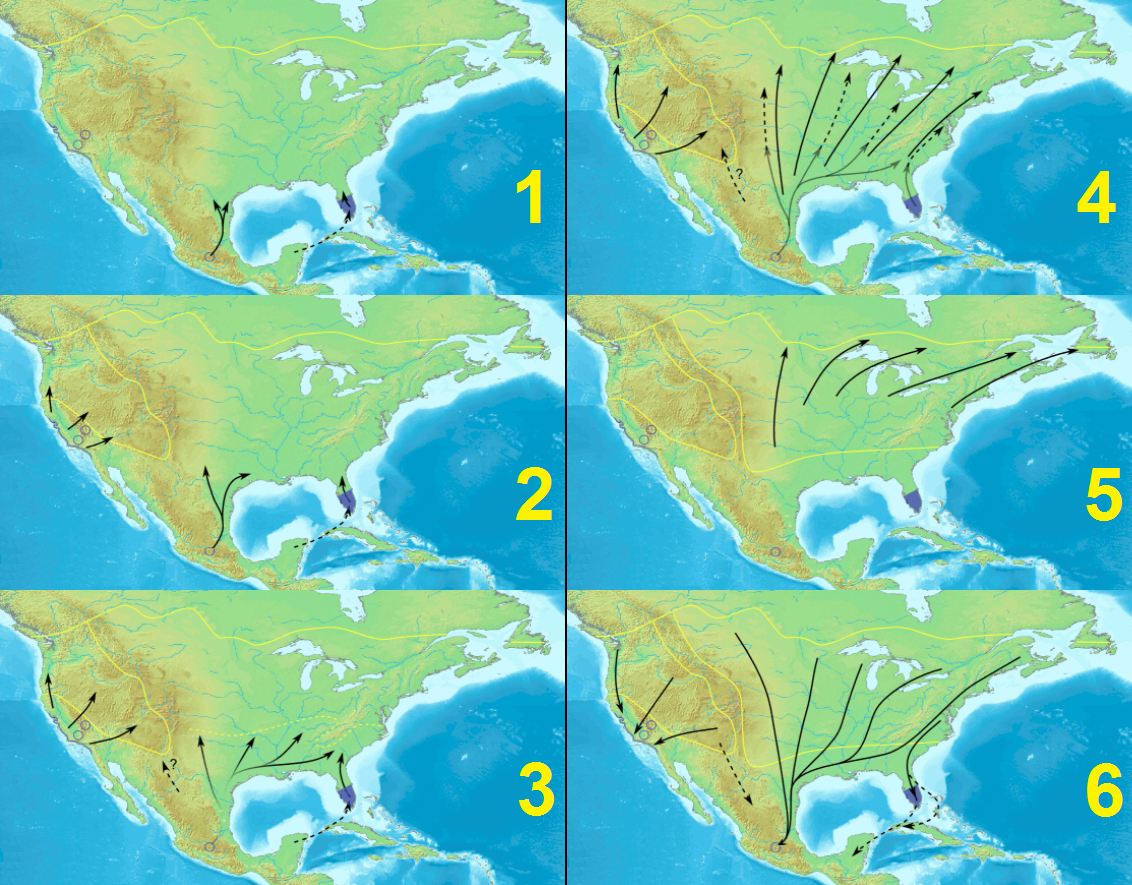|
Insect Migration
Insect migration is the seasonal movement of insects, particularly those by species of dragonfly, dragonflies, beetles, butterfly, butterflies and moths. The distance can vary with species and in most cases, these movements involve large numbers of individuals. In some cases, the individuals that migrate in one direction may not return and the next generation may instead migrate in the opposite direction. This is a significant difference from bird migration. Definition All insects move to some extent. The range of movement can vary from within a few centimeters for some sucking insects and wingless aphids to thousands of kilometers in the case of other insects such as locusts, butterfly, butterflies and dragonflies. The definition of migration is therefore particularly difficult in the context of insects. A behavior-oriented definition proposed is This definition disqualifies movements made in the search of resources and which are terminated upon finding the resource. Migration ... [...More Info...] [...Related Items...] OR: [Wikipedia] [Google] [Baidu] |
Bogong Moth
The bogong moth (''Agrotis infusa'') is a temperate species of Nocturnal, night-flying moth, notable for its biannual long-distance seasonal Lepidoptera migration, migrations towards and from the Australian Alps, similar to the diurnal monarch butterfly. During the autumn and winter it is found in southern Queensland, western New South Wales, western Victoria (Australia), Victoria, and also in South Australia, South and Western Australia. Adult bogong moths breed and larvae hatch during this period, consuming winter pasture plants during their growth. During the Spring (season), spring, the moths migrate south or east and reside in mountains such as Mount Bogong, where they gregariously Aestivation, aestivate over the summer until their return towards breeding grounds again in the autumn. The moth's name, ''bogong'', is derived from an Australian Aboriginal languages, Australian Aboriginal language; the Dhudhuroa language, Dhudhuroa word ''bugung'' describes the brown colourati ... [...More Info...] [...Related Items...] OR: [Wikipedia] [Google] [Baidu] |
Schistocerca Gregaria
The desert locust (''Schistocerca gregaria'') is a species of locust, a periodically swarming, short-horned grasshopper in the family Acrididae. They are found primarily in the deserts and dry areas of northern and eastern Africa, Arabia, and southwest Asia. During population surge years, they may extend north into parts of Southern Europe, south into Eastern Africa, and east in northern India. The desert locust shows periodic changes in its body form and can change in response to environmental conditions, over several generations, from a solitary, shorter-winged, highly fecund, non-migratory form to a gregarious, long-winged, and migratory phase in which they may travel long distances into new areas. In some years, they may thus form locust plagues, invading new areas, where they may consume all vegetation including crops, and at other times, they may live unnoticed in small numbers. During plague years, desert locusts can cause widespread damage to crops, as they are highly mob ... [...More Info...] [...Related Items...] OR: [Wikipedia] [Google] [Baidu] |
SGR Laying
SGR may refer to: * Heart Colchester and Heart Ipswich, radio stations in Suffolk, England both once known as SGR * Sagittarius (constellation) abbreviation * '' Scary Go Round'', a webcomic * Scientists for Global Responsibility, a United Kingdom group that promotes the ethical practice and use of science and technology * Segar LRT station in Bukit Panjang, Singapore (LRT station abbreviation) * Select Graphic Rendition (ANSI), an ANSI X3.64 escape sequence * Service Général du Renseignement et de la Sécurité, the French name of the Belgian General Information and Security Service * SGR (band), a ska band from New Jersey, United States * Shale Gouge Ratio, a mathematical algorithm aiming to predict the fault rock types for simple fault zones * The Shaw Group, a company which formerly used as its ticker symbol * Slade Green railway station in London, England (National Rail station code) * Smart Green Resilient (planning concept) abbreviation * Societa' di Gestione del Ri ... [...More Info...] [...Related Items...] OR: [Wikipedia] [Google] [Baidu] |
Monarch Butterfly Migration
Monarch butterfly migration is the phenomenon, mainly across North America, where the subspecies '' Danaus plexippus plexippus'' migrates each autumn to overwintering sites on the West Coast of California or mountainous sites in Central Mexico. Other populations from around the world perform minor migrations or none at all. This massive movement of butterflies has been recognized as "one of the most spectacular natural phenomena in the world". The North American monarchs begin their southern migration in September and October. Migratory monarchs originate in southern Canada and the northern United States, they travel thousands of kilometers to overwintering sites in central Mexico. The butterflies arrive at their roosting sites in November. They remain in roosts atop volcanic mountains on oyamel fir trees (''Abies religiosa'') during the winter months and then begin their northern migration in March, back to North America and southern Canada. Two to three generations of monarchs ... [...More Info...] [...Related Items...] OR: [Wikipedia] [Google] [Baidu] |
Monarch Butterfly
The monarch butterfly or simply monarch (''Danaus plexippus'') is a milkweed butterfly (subfamily Danainae) in the family Nymphalidae. Other common names, depending on region, include milkweed, common tiger, wanderer, and black-veined brown. It is among the most familiar of List of butterflies of North America, North American butterflies and an iconic pollinator, although it is not an especially effective pollinator of milkweeds. Its wings feature an easily recognizable black, orange, and white pattern, with a wingspan of . A Müllerian mimic, the viceroy butterfly, is similar in color and pattern, but is markedly smaller and has an extra black stripe across each hindwing. The eastern North American monarch population is notable for its annual southward late-summer/autumn instinctive Monarch butterfly migration, migration from the northern and central United States and southern Canada to Florida and Mexico. During the fall migration, monarchs cover thousands of miles, with a co ... [...More Info...] [...Related Items...] OR: [Wikipedia] [Google] [Baidu] |
Vanessa Cardui
''Vanessa cardui'' is the most widespread of all butterfly species. It is commonly called the painted lady, or formerly in North America the cosmopolitan. Description File:Vanessa cardui MHNT CUT 2013 3 14 Pontfaverger-Moronvilliers Dos.jpg, Dorsal side File:Vanessa cardui MHNT CUT 2013 3 14 Pontfaverger-Moronvilliers Ventre.jpg, Ventral side File:Vanessa cardui - egg 02 (HS).jpg, Egg File:Vanessa cardui - caterpillar 07 (HS).jpg, Larva File:Vanessa cardui - pupa 03 (HS).jpg, Pupa File:Painted Lady Chrysalis micro CT.jpg, Inside Pupa File:Vanessa cardui - chrysalis and emergence.jpg, Emergence Distribution ''V. cardui'' is one of the most widespread of all butterflies, found on every continent except Antarctica and South America. In Australia, ''V. cardui'' has a limited range around Bunbury, Western Australia, Bunbury, Fremantle, Western Australia, Fremantle, and Rottnest Island. However, its close relative, the Australian painted lady (''V. kershawi'', sometimes consid ... [...More Info...] [...Related Items...] OR: [Wikipedia] [Google] [Baidu] |
Vanessa (butterfly)
''Vanessa'' is a genus of brush-footed butterflies in the tribe Nymphalini. It has a near-global distribution and includes conspicuous species such as the red admirals (e.g., red admiral, Indian red admiral, New Zealand red admiral), the Kamehameha, and the painted ladies of the '' Cynthia'' group (formerly a subgenus): Painted lady, American painted lady, West Coast lady, Australian painted lady, etc. For African admirals, see genus '' Antanartia''. Recently, several members traditionally considered to be in the genus '' Antanartia'' have been determined to belong within the genus ''Vanessa''. The name of the genus may have been taken from the character Vanessa in Jonathan Swift's poem " Cadenus and Vanessa," which is the source of the woman's name Vanessa. In the poem Vanessa is called a "nymph" eleven times, and the genus is closely related to the previously-named genus Nymphalis. Though the name has been suggested to be a variant of "Phanessa", from the name of an ... [...More Info...] [...Related Items...] OR: [Wikipedia] [Google] [Baidu] |
Nymphalidae
The Nymphalidae are the largest family of butterflies, with more than 6,000 species distributed throughout most of the world. Belonging to the superfamily Papilionoidea, they are usually medium-sized to large butterflies. Most species have a reduced pair of forelegs and many hold their colourful wings flat when resting. They are also called brush-footed butterflies or four-footed butterflies, because they are known to stand on only four legs while the other two are curled up; in some species, these forelegs have a brush-like set of hairs, which gives this family its other common name. Many species are brightly coloured and include popular species such as the emperors, monarch butterfly, admirals, tortoiseshells, and fritillaries. However, the under wings are, in contrast, often dull and in some species look remarkably like dead leaves, or are much paler, producing a cryptic effect that helps the butterflies blend into their surroundings. Nomenclature Rafinesque i ... [...More Info...] [...Related Items...] OR: [Wikipedia] [Google] [Baidu] |
Pieridae
The Pieridae are a large family (biology), family of butterflies with about 76 genera containing about 1,100 species, mostly from Afrotropical realm, tropical Africa and Indomalayan realm, tropical Asia with some varieties in the more northern regions of North America and Eurasia.DeVries P. J. in Levin S.A. (ed) 2001 The Encyclopaedia of Biodiversity. Academic Press. Most pierid butterflies are white, yellow, or orange in coloration, often with black spots. The pigments that give the distinct coloring to these butterflies are derived from waste products in the body and are a characteristic of this family.Carter, David (2000). ''Butterflies and Moths''. The family was created by William Swainson in 1820. The name "butterfly" is believed to have originated from a member of this family, the brimstone, ''Gonepteryx rhamni'', which was called the "butter-coloured fly" by early British naturalists. The sexes usually differ, often in the pattern or number of the black markings. The l ... [...More Info...] [...Related Items...] OR: [Wikipedia] [Google] [Baidu] |
Monsoon
A monsoon () is traditionally a seasonal reversing wind accompanied by corresponding changes in precipitation but is now used to describe seasonal changes in Atmosphere of Earth, atmospheric circulation and precipitation associated with annual latitudinal oscillation of the Intertropical Convergence Zone (ITCZ) between its limits to the north and south of the equator. Usually, the term monsoon is used to refer to the Wet season, rainy phase of a seasonally changing pattern, although technically there is also a dry phase. The term is also sometimes used to describe locally heavy but short-term rains. The major monsoon systems of the world consist of the Monsoon#Africa (West African and Southeast African), West African, Asian–Australian monsoon, Australian, the North American monsoon, North American, and South American monsoons. The term was first Glossary of the British Raj, used in English in British India and neighboring countries to refer to the big seasonal winds blowin ... [...More Info...] [...Related Items...] OR: [Wikipedia] [Google] [Baidu] |





